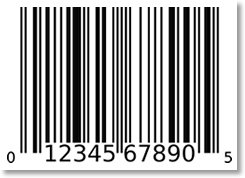The ABCs of UPC
 The Beginning of UPC
The Beginning of UPC
Universal Product Codes (UPC) have been around since the 1950s in some form or fashion, though not widely used. In the sixties and seventies, mass retail outlets were looking to use technology to speed up and accurately assess the handling of merchandise and inventory using standardized product identification.
In 1970 the Grocery Manufacturing Association, the Supermarket Institute, and the National Association of Food Chains held a meeting to form The UPC Ad Hoc Committee with representative members from corporations like Kroger, General Mills, HJ Heinz, and Bristol-Meyers. The Ad Hoc committee spawned the Symbol Selection committee, which voted in 1973 to accept the UPC symbol created by IBM.
From the inception, UPC bar codes (symbols) have been used to encode Global Trade Item Numbers (GTIN), which uniquely identify individual items. These identifiers are used in tracking goods through the entire supply chain: inventory, shipping, warehousing, stocking, and ultimately, check out or purchase.
According to a Price Waterhouse Coopers study, the average grocery store in 1974 carried 9,000 SKUs. In 1997, the average store carried 30,000. The jump in merchandise volume is attributed to the advancements of UPC, making it easier for managers to control price changes, promotions, and product assortments.
UPC Today
In 2005, GS1 was created from what used to be the Uniform Code Council, the entity that administered bar code standards. The GS1 System of standards is one of the most globally used supply chain standards, serving over 200,000 businesses in the United States alone.
Bar codes, simplistically, are symbols that encode data. According to the GS1 website, a UPC-A bar code, the most common form, consists of three elements:
- A 6 to 9 digit company pre-fix.
- An item reference number that completes the UPC’s first 11 digits.
- A twelfth check digit, calculated by a special formula using the first 11 digits.
A UPC-E bar code is a compressed version of UPC-A. To be scanned by retail scanners, bar codes must have a fixed height to width ratio, which creates a minimum size requirement. So, the UPC-E bar code requires 8 digits and can fit onto smaller packaging.
The Future of UPC
Currently, GS1 is implementing a new type of bar code, the GS1 DataBar™, which can carry more information and identify smaller items than the UPC bar codes. DataBar can also carry serial numbers, lot numbers, and expirations dates, which is ideal for tracking fresh food products.
GS1 has set a target date of 2014 for DataBar standards to be used by all trading partners in an open environment. Currently, the specific focus is on fresh products scanned at retail point-of-sale.
Kroger has begun scanning the DataBar on loose produce and coupons. Kroger tested the DataBar on in-store-produced meat items, finding that they were able to consistently print the bar code and read it at checkout without any errors in scanning. By incorporating the expiration dates into the codes, grocers will be able to prevent the sale of out-of-date items, analyze stock-outs, and improve order rates. Ideally, when used on produce, the DataBar will improve the accuracy of those transactions too, accurately scanning organic produce, for example.
See related articles:
How to Look Up a Bar Code Number
{jcomments on}
